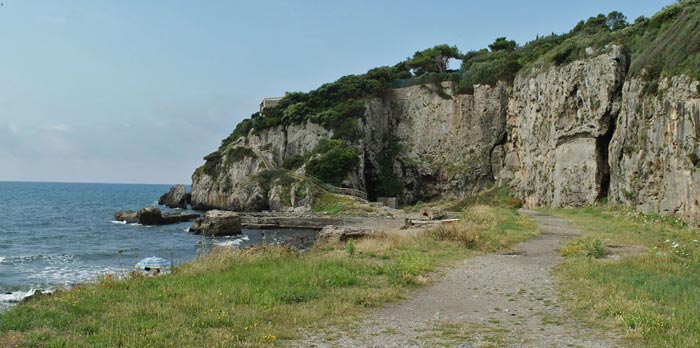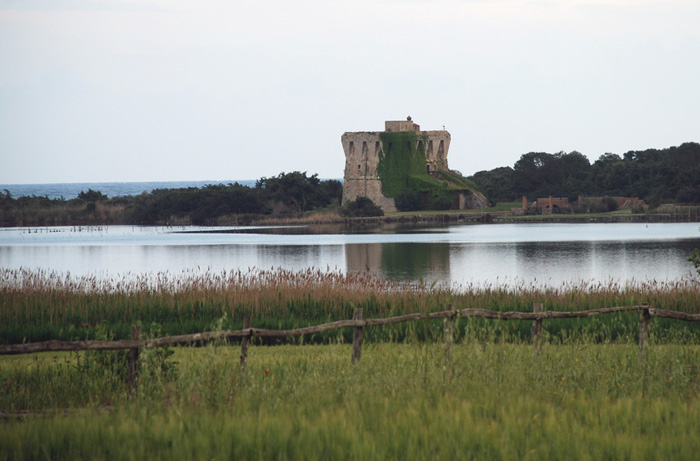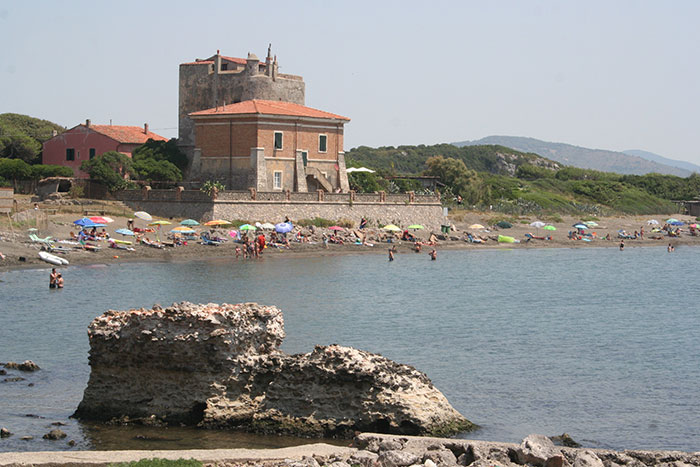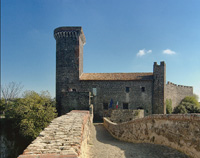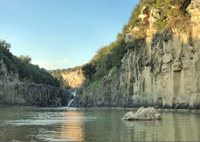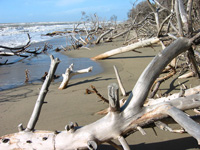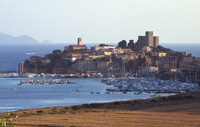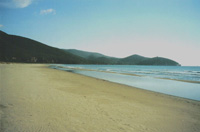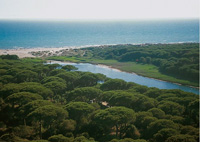| |
|
The southernmost part of Tuscany and the island of Elba have a very different feel to any other Tuscan region. Thanks to the hotter, drier and sunnier climate, the hills are cloaked in aromatic Mediterranean scrub, known as macchia.
The region slumbered from Roman times and for long periods was virtually uninhabited except for farmers and fishermen.
The ancient Etruscans, followed by the Romans, drained its swamps to create richly fertile farming land. After the collapse of the Roman Empire, the drainage channels became choked, turning the Maremma into an inhospitable wilderness of marshland and stagnant pools plagued by malaria-carrying mosquitoes.
Re-draining of the land began again in the late 18th century and, with the help of insecticides, the malaria-mosquito was finally eliminated in the 1950s.
Ansedonia is a prosperous village of luxurious villas and gardens, high on a hill above the coast. The ruins of the city of Cosa, founded by the Romans in 173 BC, are on the summit of the hill looking over Ansedonia. The Museo di Cosa, containing relics from the ancient settlement, is close by. East of Ansedonia is a long stretch of sandy beach and the remains of the Etruscan Canal. The date and purpose of the canal are debatable, but it may have been dug in Roman times to keep the harbour free of silt. Alternatively, it may have been part of a canal leading to the Lago di Burano, 5 km (3 miles) down the coast. This lagoon is 4 km (2.5 miles) long and has been turned into a wildlife refuge (rifugio faunistico) by the Worldwide Fund for Nature. It is a very important habitat for wading birds.
Directly across the harbor from Porto Ercole lies Ansedonia, an almost sleepy little town with some of the best beach front in Tuscany. Rather than the rocks and pebbles that greet you on so many Italian beaches, Ansedonia offers soft, velvety sand.
Ansedonia flourished in the 60's, with well-known architects of the time designing villas for the rich and famous, mostly in the mass-media circuit. Now, it is seen more as a retro relic of the past society.
Above Ansedonia, in the archeological zone, lie the ruins of the Roman city of "Cosa". Below, on the slopes near the sea, lies the peaceful residential zone with numerous villas set in green vegetation offering direct contact with nature.
The ancient city of Cosa, situated on a small rocky promontory 114 meters above sea level, was in historic times connected to the primitive island of Argentario by a thin strip of land referred to as the Tombolo di Feniglia.
Its foundation dates back to 273 B.C. in which it became a Roman colony after the territory was conquered by the Consul Tiberius Coruncanio. The name Cosa itself derived from the ancient name "Cusi" or "Cusia", corresponding to a small Etruscan center established where Orbetello lies today.
It seems that Cosa was developed as a strategic point in the water in the middle of the Tyrrheanian Sea since battles with Carthage were anticipated, thus its location was not by chance.
The Romans, thanks to new military techniques acquired during the Samnite war and the campaigns of Pyrrhus, erected, also in Cosa, a mighty enclosed wall with three access ports to the city, which were constructed with enormous polygonal masses of limestone embedded between them; they also erected 17 square towers situated on the side facing the sea.
The Cosa Museum | Via delle Ginestre, Ansedonia | url (it)
The museum has been established by the American Academy in Rome in collaboration with the Archeological Office. It contains archeological documents from excavations in the area of the city and the ancient port of Cosa. It is divided in three sections: the Acropolis, the Casa Romana (Roman house) and the Forum.
In the harbor area one can see the remains of a large maritime villa which was extended along the beach up to the dunes and further out behind the actual road.
Part of the structure is covered by the Puccini Tower and the adjacent buildings whilst the part situated along the beach is more visible.
The body of the villa is a regular rectangular which length from the beach up to the northern perimeter wall is 120 m; and 50 m. wide with two less important wings on the south side.
Large groups of construction connected by corridors and having special purposes can be seen. The north side could have been an 'ambulate' situated on the fresher side of the complex and must have had a monumental entrance to the central part corresponding to the residential area built around a peristil. The thermal rooms are found on the opposite side sheltered by the tower.
On the south a large 'ambulate' was connecting the residential area to the production and the harbor ones and was extending into a western and an eastern wing.[2] n
The port, presumably founded with the early Latin colony on the hill above in 273 B.C., is the earliest Roman harbor thus far known.(…)
Some 250 m. behind the port across the sand dunes, lies an ancient fishing lagoon, now silted over. The excavations have revealed the earliest commercial Roman fishery thus far discovered, equipped with long fish tanks and a fresh water spring contained in a Spring House on its western embankment. The discovery within the house of the remains of a wooden water-lifting device known as a saqiya from its common Arabic term, is a unique find. It provides the earliest archaeological evidence for this device still in use today. The identification of the Portus Cosanus as the likely manufacturing and distribution point for the famous Sestius amphora jars suggests that Cosa was a key trading center during the late Republic for fish products as well as wine.![3]
|
|
|
|
| |
|
 |
|
 |
|
 |
| Il forte di Macchiatonda |
|
La porta di Cosa |
|
Vista da Cosa verso la costa di Vulc
i |
There are a number of nude beaches in Tuscany, including one near Capalbio. The coast of Capalbio extends about 12 km from the border of Ansedonia all the way to the end of Tuscany. A naturist beach can be found at Macchiatonda beach. At the forte di Macchiatonda you have to walk for 20 minutes south.
Part of Feniglia beach (Tombolo di Feniglia) is dedicated to naturists. The Naturist area is in the central part of the beach, the less frequented.
Nudist beaches in Tuscany | La costa, le spiagge e il mare della Toscana naturista
The most beautiful beaches of Tuscany | From Principina a Mare to Ansedonia
|
|
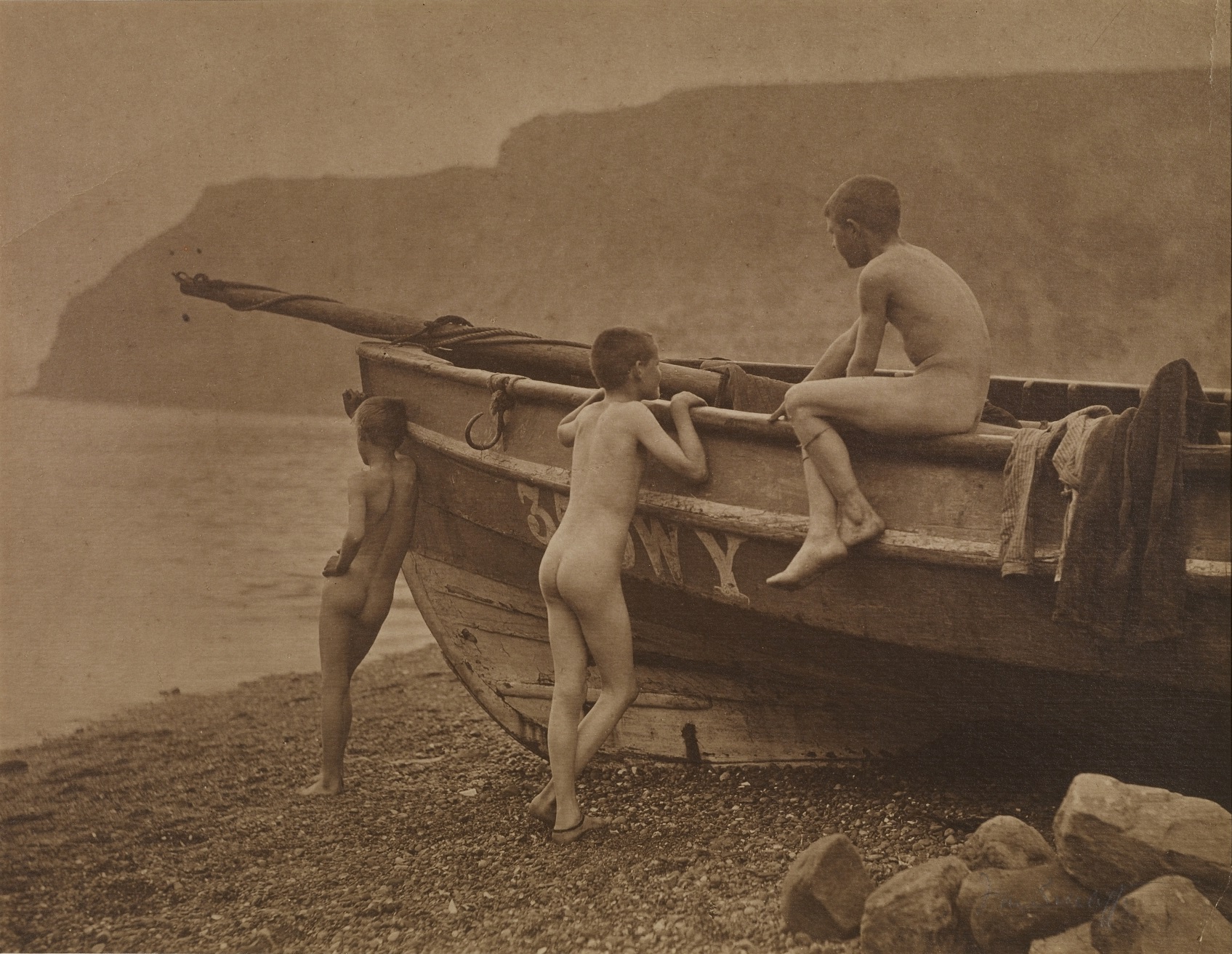 |
| |
|
|
|
|
|
| |
|
|
|
|
|
| |
|
|
|
|
|
|
|
|
|
Vulci, Castello della Badia |
|
The oasis Vulci extends along the river Fiora, where a water fall has originated a small lake, lago Pellicone, where it is possible to bathe.
|
|
From the sea in a pine wood on the borders of the Parco Naturale della Maremma
|
|
|
|
|
|
Talamone |
|
Marina di Albarese
The most famous part of the Maremma is the Parco Naturale della Maremma, otherwise known as the Parco dell'Uccellina
|
|
Principina a Mare
The Ombrone River located along the coast of Maremma Grossetana, where it flows into the Tyrrhenian Sea in Principina a Mare.
|
Maps available in Podere Santa Pia
Kompass 651 (2005), Maremma, Argentario, Grosseto, Isola del Gigilo 1 : 50 000.
Edizioni Multigraphic, Parco di Montioni - Alta Maremma 1 : 25 000.

[1] Many evenings, one of the officers recalls in a memoir I came across in our friends’ villa, il Maestro shared "la nostra modesta tavola" (our modest table), "mangiando persino il nostro minestrone" (even eating our soup). The celebrated composer, "forse nauseato dalla vita spesso falsa delle alte sfere sociali" (perhaps sick of the often false life of the high social spheres), seemed to prefer "la semplicità e la sincerità" (the simplicity and sincerity) of the men who guarded the wild coast from pirates.
On the evening of December 25, 1920, Puccini invited the commandant to listen with him as the librettist Giuseppe Adami read the first act of the opera Turandot, the story of una principessa cinese (a Chinese princess) whose cold heart is melted by love. The two men listened in silence in "quella desolata culla della civiltà etrusca" (that desolate cradle of Etruscan civilization).
That very night Puccini sat down at his piano and filled the stillness with le note felici (happy notes). His uniformed friend smiled as he listened to the onde di melodia (waves of melody) accompanied by the fragorosa cadenza del mare (resounding cadence of the sea).
The men of the Guardia in Ansedonia celebrated the immancabile successo (inevitable success) of Turandot, despite their grief for the Maestro who showed such grande ammirazione e affetto (great admiration and affection) for them and for whom they felt imperitura devozione (everlasting devotion).
[See more at: www.becomingitalianwordbyword.typepad.com]
[2] Annalisa Marzano, Roman Villas in Central Italy: A Social and Economic History, p. 34.
The traditional typology of Italian villas is divided into two broad groups: the courtyard-villa and the portico-villa. If we focus on the architectural typology, coastal villaspresent recurrent features, and almost always fall into the category of portico-villas. The use of substructures, forming the basis villae, and of various terraces on which the building unfolds is a recurrent theme, not only
when the morphology of the terrain required this type of engineering solution, but also when the terrain was rather flat and high cliffs were absent.'
[3] Anna Marguerite McCann, The Harbor and Fishery Remains at Cosa, Italy, Journal of Field Archaeology
Vol. 6, No. 4 (Winter, 1979), pp. 391-411
[Published by: Maney Publishing | Article Stable URL:http://www.jstor.org/stable/529424]
This article is a précis of the publication of the excavations at the Roman port of Cosa in Italy now being prepared by the author and 21 specialists in various fields. The excavations were begun in 1968, following a survey in 1965 both on land and underwater. (…) The remains of the port are described along with its concrete masonry piers which probably date from the late 2nd or early 1st century B.C., supplying the earliest dated evidence for the use of tufo and pozzolana concrete in water. (…)
The earliest material from the port dates to the 3rd century B.C. with the latest material dating in the 3rd century A.C. The main period of its prosperity, documented largely by the unusual concentration of the Sestius amphora fragments, is dated from the late 2nd century B.C. through sometime in the later 1st century B.C. There was a revival of activity in the port and lagoon fishery by the 2nd and 3rd centuries A.C. when the unexcavated seaside villa on the beach at Cosa, as well as others in the area, were flourishing.
References
E. Gazda, “The Port and Fishery: Description of Extant Remains and Sequence of Construction,” in McCann et al., 1987, 74-97.
E. Gazda, “Cosa’s Contribution to the Study of Roman Hydraulic Concrete: An Historiographic Commentary,” in N.W. Goldman, ed., New Light from Ancient Cosa (New York, 2002) 145-77.
E. Gazda, “Cosa’s Hydraulic Concrete: Towards a Revised Chronology.” To appear in R.L. Hohlfelder, ed., The Maritime World of Ancient Rome, Papers of a conference held at the American Academy in Rome, 27-29 March 2003 (Ann Arbor, Forthcoming 2004).
Anna-Marguerite McCann, et al., The Roman Port and Fishery of Cosa, Princeton, 1987.
Roman villas
Whereas houses in Pompeii turned a blank wall to the busy streets, the exteriors of the opulent maritime villas were lined with long, colonnaded walkways that offered sweeping vistas of the sea. The small frescoes illustrate their appearance. Such frescoes often adorned the walls of Pompeian houses, perhaps reflecting the owner's desire for a magnificent country retreat. Others have been found in the villas themselves, as if the landowner could enjoy a bird's-eye view of his domain even while indoors.[www.nga.gov]
Wines in Tuscany
La Corsa
|
La Corsa Società Agricola S.r.l. is located on the gentle slopes of Tuscany’s Maremma, within the impressive triangle of the Golden Valley, whose apex is overlooking Ansedonia’s bay.
The farm La Corsa was identified and purchased by telecommunications manager Marco Bassetti, a great lover of food and wine. He discovered archeological remains for wine production within the property of La Corsa.
The archeological findings in this area testify that Romans, for the production of their best wines, beside choosing this triangle of land among all the terrains in the Maremma, were also ahead of time in the modern terroir concept.
The Villa delle Colonne, the Fattoria di Giardino, the Villa di Settefinestre, the finds discovered in the roman agrarian settlements, and the Acquedotto delle Forane Monte Nebbiello, are further examples to help understand how valuable this strip of land must have been in the ancient times.
The wine project of La Corsa started in 2005, it is conducted under the supervision of the winemakers Vittorio Fiore and Barbara Tamburini.
La Corsa Società Agricola S.r.l.
Strada Provinciale del Prataccione, 19
58015 Orbetello Scalo (GR) |
|
|
